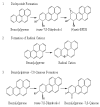Photoirradiation of polycyclic aromatic hydrocarbons with UVA light - a pathway leading to the generation of reactive oxygen species, lipid peroxidation, and dna damage
- PMID: 17159277
- PMCID: PMC2701161
- DOI: 10.3390/ijerph2006030045
Photoirradiation of polycyclic aromatic hydrocarbons with UVA light - a pathway leading to the generation of reactive oxygen species, lipid peroxidation, and dna damage
Abstract
Polycyclic aromatic hydrocarbons (PAHs) are a class of genotoxic environmental contaminants. We have long been interested in determining the mechanisms by which PAHs induce genotoxicity. Although the metabolic activation of PAHs leading to biological activities has been well studied, the photo-induced activation pathway has seldom reported. In this paper, we review the study of photoirradiation of PAHs with UVA irradiation results in (i) cytotoxicity and DNA damage (ii) DNA single strand cleavage; (iii) formation of 8-hydroxy-2'-deoxyguanosine adduct (8-OHdG), and (iv) formation of lipid peroxidation. Evidence has been shown that these photobiological activities are mediated by reactive oxygen species (ROS).
Figures




Similar articles
-
UVA photoirradiation of nitro-polycyclic aromatic hydrocarbons-induction of reactive oxygen species and formation of lipid peroxides.Int J Environ Res Public Health. 2013 Mar 14;10(3):1062-84. doi: 10.3390/ijerph10031062. Int J Environ Res Public Health. 2013. PMID: 23493032 Free PMC article.
-
Phototoxicity and environmental transformation of polycyclic aromatic hydrocarbons (PAHs)-light-induced reactive oxygen species, lipid peroxidation, and DNA damage.J Environ Sci Health C Environ Carcinog Ecotoxicol Rev. 2012 Jan;30(1):1-41. doi: 10.1080/10590501.2012.653887. J Environ Sci Health C Environ Carcinog Ecotoxicol Rev. 2012. PMID: 22458855 Review.
-
Photoirradiation of representative polycyclic aromatic hydrocarbons and twelve isomeric methylbenz[a]anthracene with UVA light: formation of lipid peroxidation.Toxicol Ind Health. 2006 May;22(4):147-56. doi: 10.1191/0748233706th259oa. Toxicol Ind Health. 2006. PMID: 16786836
-
UVA photoirradiation of halogenated-polycyclic aromatic hydrocarbons leading to induction of lipid peroxidation.Int J Environ Res Public Health. 2006 Jun;3(2):191-5. doi: 10.3390/ijerph2006030022. Int J Environ Res Public Health. 2006. PMID: 16823092 Free PMC article.
-
Exposure to polycyclic aromatic hydrocarbons: bulky DNA adducts and cellular responses.Exp Suppl. 2012;101:107-31. doi: 10.1007/978-3-7643-8340-4_5. Exp Suppl. 2012. PMID: 22945568 Review.
Cited by
-
Structure-dependent lipid peroxidation by photoirradiation of pyrene and its mono-substituted derivatives.J Environ Sci Health A Tox Hazard Subst Environ Eng. 2013;48(3):233-41. doi: 10.1080/10934529.2013.729998. J Environ Sci Health A Tox Hazard Subst Environ Eng. 2013. PMID: 23245298 Free PMC article.
-
Additive effect of combined pollutants to UV induced skin OxInflammation damage. Evaluating the protective topical application of a cosmeceutical mixture formulation.Redox Biol. 2020 Jul;34:101481. doi: 10.1016/j.redox.2020.101481. Epub 2020 Apr 18. Redox Biol. 2020. PMID: 32336667 Free PMC article.
-
Single and Combined Effects of Phenanthrene and Silver Nanoparticles on Denitrification Processes in Coastal Marine Sediments.Microorganisms. 2024 Apr 6;12(4):745. doi: 10.3390/microorganisms12040745. Microorganisms. 2024. PMID: 38674689 Free PMC article.
-
Light-induced cytotoxicity of 16 polycyclic aromatic hydrocarbons on the US EPA priority pollutant list in human skin HaCaT keratinocytes: relationship between phototoxicity and excited state properties.Environ Toxicol. 2007 Jun;22(3):318-27. doi: 10.1002/tox.20241. Environ Toxicol. 2007. PMID: 17497637 Free PMC article.
-
The Damaging Effects of Long UVA (UVA1) Rays: A Major Challenge to Preserve Skin Health and Integrity.Int J Mol Sci. 2022 Jul 26;23(15):8243. doi: 10.3390/ijms23158243. Int J Mol Sci. 2022. PMID: 35897826 Free PMC article. Review.
References
-
- Connell DW, Hawker DW, Warne MJ, Vowles PP. Polycyclic aromatic hydrocarbons (PAHs) In: McCombs K, Starkweather AW, editors. Introduction into Environmental Chemistry. CRC Press; LLC, Boca Raton, FL: 1997. pp. 205–217.
-
- Shaw GR, Connell DW. Prediction and monitoring of the carcinogenicity of polycyclic aromatic compounds (PACs) Rev Environ Contam Toxic. 1994;135:1–62. - PubMed
-
- Dipple A. Polycyclic Aromatic Hydrocarbons and Carcinogenesis. American Chemical Society; Washington, DC: 1985.
Publication types
MeSH terms
Substances
Grants and funding
LinkOut - more resources
Full Text Sources
